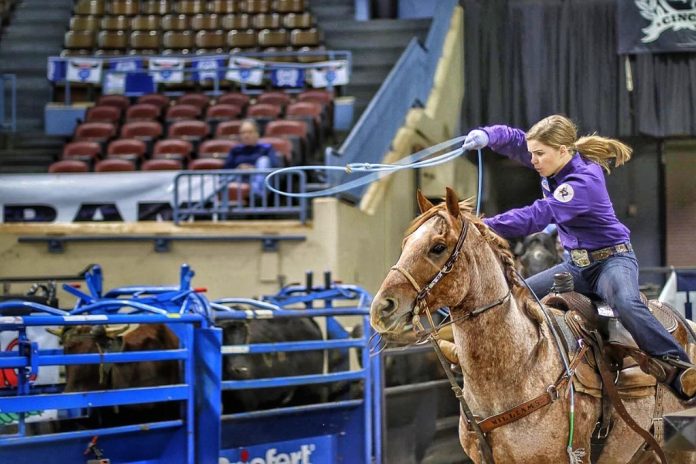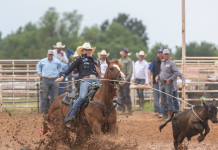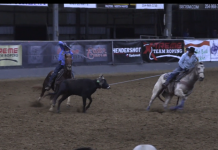Breaking it Down by Speed Williams – October 2023
Whether you’re heading, heeling, or breakaway roping the barrier comes into play, in a big way. My kids compete in all three and I want to talk about what I do to help them and the clients who come to me for lessons.
Everyone has certain steers or calves they struggle with. Since the World Series barrier is used in many of the low numbered ropings, it’s made it difficult for young people to learn to score and prepare for amateur rodeos. Denny Gentry came up with this idea so heelers would have a chance to throw their rope since many headers break the barrier and still don’t get a chance to throw. We all know heelers hate to run down the pen without getting to throw their rope. In the old days, contractors got carried away and stretched it out where a low percentage of teams would catch in the first round.
Now they have figured out how to make it more difficult with a long box over 21’, moving the barrier out a few more inches, and you have to sit dead still when the gate opens. It becomes way more complicated. If the WSTR barrier is set up right and your steer leaves, you can pretty much go right behind the gate opening. But there is an art being able to have your horse leave off your hand and not just when you nod. I work on this with both of kids: Gabe with his heading and Hali in the breakaway. Scoring and getting a good start with your horse coming across the line is so important in both events.
Whether it’s my kids or clients, we first work on the Speed Trainer. How it works is you have contact with the horse and the green light is on. The harder you pull; more lights will light up on the horse. There’s no noise with just the green light on. One of my first drills is with the green light on, I say “Ready, set, go!” Then you drop your hand, stand up in the saddle, ride the stirrups kicking with your butt out of the seat, swing your rope at the same time. Two swings and be able to rope the target from many different angles. I may put the calf or steers close, or I may move them to the right.
You wouldn’t believe how many #4, #5, #6 and even a few #7’s will pull on the horse when they get out of the saddle. Most don’t realize they are pulling themselves up by the bridle reins instead of riding the stirrups across the line. Scoring, riding across the line, and being ready to rope fast is something I constantly work on with my kids and clients.
Getting a good start usually makes catching the cow much easier. This is one of the reasons the Speed Trainer was built. I wanted a way to teach my kids how to ride their horse and rope at the same time.
Don’t get me wrong, I have spent hours on the ground doing all kinds of drills. But the math and angles are not the same and it’s much different balancing in the saddle versus standing on the ground. It’s harder to rope on the Speed Trainer because you have to create the momentum with your swing. It really exposes whether you have a good fundamental swing or have too many wasted motions.
Look back at the runs you’ve made in the last month and evaluate how many times the start was the deciding factor whether you won or lost. Then think about how much time you spend on your scoring and learning to communicate with your horse. For a header to learn to get better, scoring is one of the hardest things for low number ropers to learn.
One of the biggest problems with headers is when the gates bang, they pull on their horse before the horse ever tries to move. The horse gets to where they jump when the gate bangs, trying to get away from the bridle. The worst thing I see people do when they score is change the way they rope. If you score to let your horse know you’re scoring, there’s no benefit. You need to score with the same intensity as if you’re roping the steer.
If you ride a variety of horses, then you know not many score the same. You need to be willing to change and ride each horse differently. It sounds complicated, but a horse is a creature of habit and they’ve developed a pattern. You’re better off learning to score the way he’s been taught than to try and change a teenage horse to score your way.
There’s many philosophies and ways to score. I want my horse to score like the bridle reins are a gas pedal. If I release the reins slow, I want my horse to go slow. If I drop my hand fast, I want him to leave fast. When you’re able to have your horse do that it makes getting a good start much easier.
What’s new with me: I just got home from Puyallup, WA, helping my daughter at the tour rodeo and then driving home from Seattle. Hali was able to win $10,000 and guarantee her seat at the Cinch Play Offs in Sioux Falls the end of September. Someone will have the opportunity to win $40,000 there in the breakaway. This rodeo will be tournament style with 12 in each event.
Currently she has a $10,000 lead in the standings with $145,000 won. It’s hard to believe she went from the end of June to the first week in August and only won $1,000 at close to 40 rodeos. Losing confidence and second guessing happens to almost everyone I know. But she has made it through that dark tunnel, and I think it will make her stronger. I’m proud of how she’s handled the ups and downs this year.
My son and Manny have still been winning. The summer rodeos have shut down and Gabe is working on his heading quite a bit. It’s been more challenging to teach him heading versus heeling. He’s started to do a lot better, and it’s made my teaching a lot easier.





thank you for taking the time to share your valuable experience
Thanks for all you do Speedy